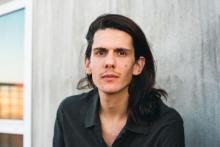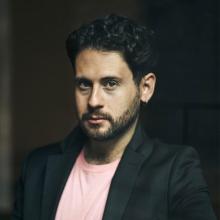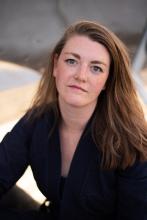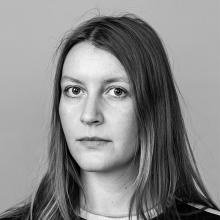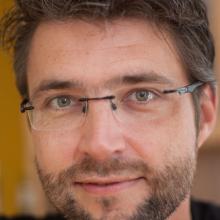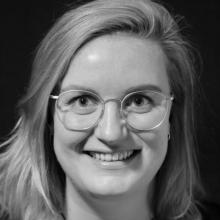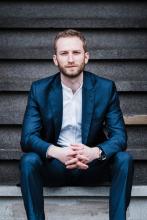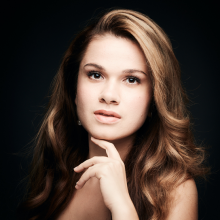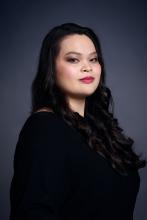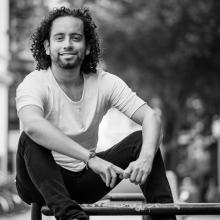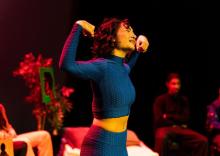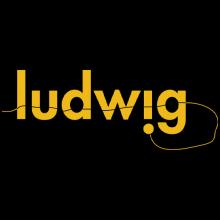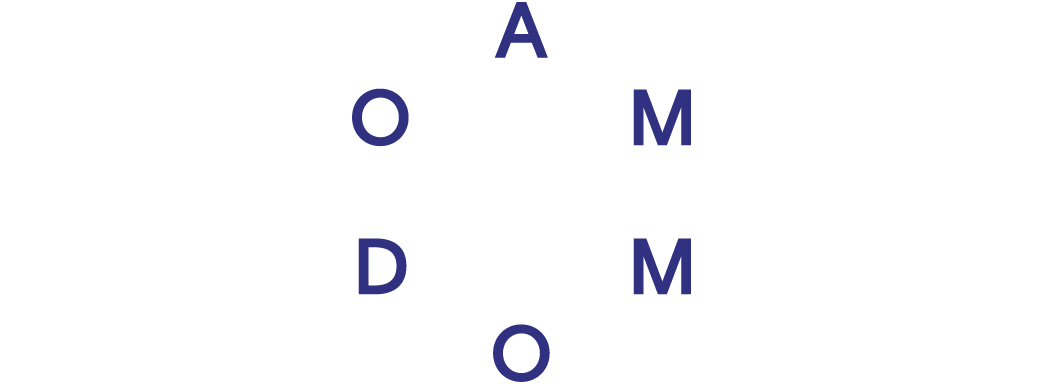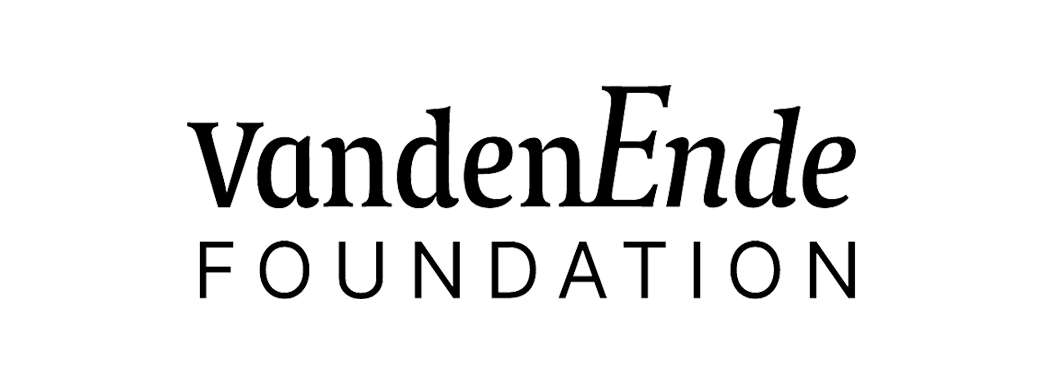Ändere die Welt!
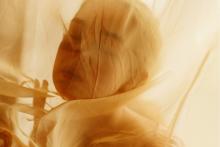
Performance information
Voorstellingsinformatie
Performance information
Duration
1 hour and 15 minutes, no interval
This performance is sung in German, English, French and Russian.
Sung texts are surtitled in Dutch and English; the English spoken word texts are not surtitled.
Dutch surtitles based on the translation of Jasmijn van Wijnen and Mart van Berckel.
English surtitles based on the translation of Michael Blass.
A pasticcio with music by various composers
Makers
Musical direction, co-creator, arranger and pianist
Pedro Beriso
Stage direction
Mart van Berckel
Set and lighting design
Vera Selhorst
Costume design
Rosa Schützendorf
Soundscape design
Wouter Snoei
Sound design
Timo Merkies
Dramaturgy
Jasmijn van Wijnen
Cast
Singers
Sam Carl**
Inna Demenkova*
Elenora Hu*
Michael Wilmering
Spoken word texts and performance
Amara van der Elst
Child actor
Bart Heyl
Kai Bartak
Finn Vogels
* Dutch National Opera Studio
** Alumnus of Dutch National Opera Studio
Orchestra
LUDWIG
Coproduction with the Nederlandse Reisopera and Opera Zuid
Ändere die Welt! was created as part of DNO's Opera Forward Festival
Production team
Assistant director
Nico Weggemans
Assistant lighting designer
Maarten van Burken
Director during performances
Mart van Berckel
Language coach
Olivier Lallouette
Stephan Rehm
Rehearsal pianist
Daniel Ruiz de Cenzano Caballero*
Stage manager
Arlette Schriek
Artistic planner
Vere van Opstal
Planner
Maarten van Grootel
Costume supervisor
Jojanneke Gremmen
Master carpenter
Luc Huisman
Lighting managers
Peter van der Sluis
Wout Panis
Stijn van Kortenhoef
Props manager
Jolanda Borjeson
Sound technicians
Timo Merkies
Kasper van der Spoel
Orchestra manager
Tatiana Matveeva
Surtitle director
Eveline Karssen
Surtitle operator
Jurjen Stekelenburg
Set supervisor
Mark van Trigt
Production management
Emiel Rietvelt
Children's supervisor
Anja ten Klooster
* Dutch National Opera Studio
LUDWIG
First violin
Floor le Coultre
Second violin
Ruña ’t Hart
Viola
Francesca Wiersma
Cello
Kalle de Bie
Double bass
Daniël Muskitta
Flute
Cristina Gonzáles
Clarinet
Stefan Woudenberg
Bassoon
Thomas Dulfer
In a nutshell: Ändere die Welt!
The climate crisis, the economic crisis, the refugee crisis, war in Europe — that something needs to change in the world is an understatement. But while we continue to cry “Ändere die Welt!” (Change the world!), history continues to repeat itself. So how do you change the world?
In a nutshell: Ändere die Welt!
The climate crisis, the economic crisis, the refugee crisis, war in Europe — that something needs to change in the world is an understatement. But while we continue to cry “Ändere die Welt!” (Change the world!), history continues to repeat itself. So how do you change the world? We are familiar with the images of revolution: from history, the French flag hoisted on top of the barricades, and in more recent times the man in Viking costume in the Capitol in America. Is revolution something that can only take place on the grand world stage, or does true change start small, with an encounter, or empathy and affection for the other?
Debris and building blocks
In Ändere die Welt!, we see a group of people who use the debris from yet another revolution as building blocks to construct a new kind of existence. Little by little, these individuals, each with their own roots and back story, converge and start to form a community: an old man, who has seen many revolutions come and go and once fought for his ideals himself; a grieving woman, who lost a loved one in the revolution; a mother with a political conscience, who wants to raise her son as a world improver out of great concern for his future; and her child as an image of the future, which confronts, activates, connects and offers hope to the adults.
Pastiche
Ändere die Welt! is a pasticcio (literally meaning pie). Historically, the heyday of the pasticcio was the eighteenth century. Italian opera was hugely popular, so a form was conceived that would let a wide audience enjoy the greatest hits from recent operas. Arias, ensembles and instrumental music from various operas by one or more composers were combined in a single production and provided with new texts or a new story. Ändere die Welt! can be seen as a modern-day variant of the pasticcio. Here too, well-known music from the opera repertoire is combined with songs, both familiar and more obscure, by composers including Schumann and Shostakovich, but above all Hanns Eisler and the cabaret songs of Kurt Weill to lyrics by Bertolt Brecht. All the music was inspired by and composed during revolutionary times. The production also combines disciplines, mixing in spoken word and electronic soundscapes.
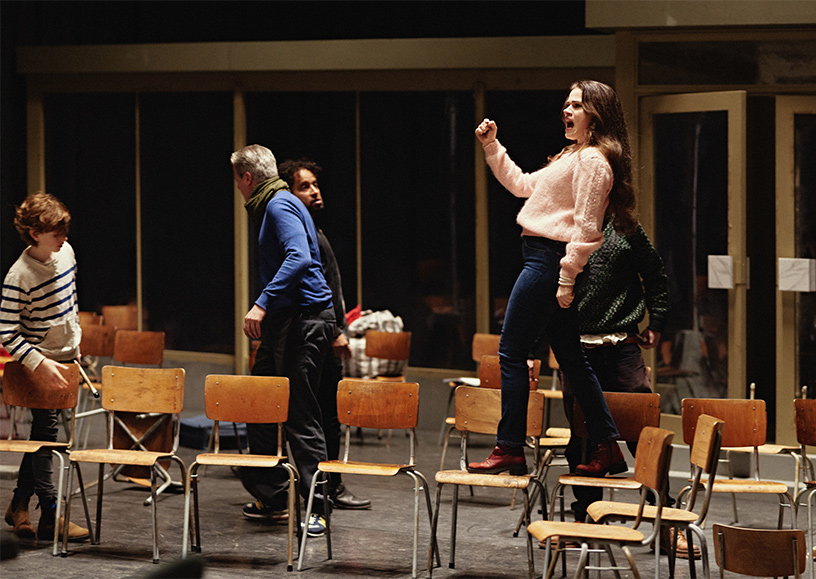
Spoken word
“If you want to create a production that says something about the world today, in 2023, and you have the opportunity to put together a new collage, it feels insufficient to use only voices from the nineteenth century and first half of the twentieth century,” says Mart van Berckel. Spoken-word artist Amara van der Elst made a deep impression in 2021 with her performance at the ceremony for the remembrance of the dead in Amsterdam’s Dam Square. In this production, she reflects on the need and quest for change from a modern-day perspective using contemporary language. Acting as a presenter, commentator, stage manager and narrator all in one, she guides the audience through the production and voices her own doubts.
Tijdloze barricades
Set and lighting designer Vera Selhorst sought an abstract, generic representation of barricades for Ändere die Welt!, something that would not be tied to a specific place or time. She opted to build the barricades from chairs; these are objects everyone has in their home and that can easily be carried out onto the street during an uprising. And when left behind in the streets, the chairs form a powerful symbol for the absence of the people who once sat on them. To then have a sense of real, relatable people moving around among the abstract decor, the costume designer Rosa Schützendorf made sure the characters look like they have just walked onto the stage straight from the street.
Activism that’s binding, not blinding
An interview with stage director Mart van Berckel
Activism that’s binding, not blinding
Dutch National Opera had two requests for Mart van Berckel: could he create a production dealing with the topic of revolution and could he do it using existing music (what is termed a pasticcio production)? In his preparatory studies, he came across a wide variety of images that influence our collective picture of revolution as a phenomenon. However, it was the images of streets and barricades after the uprising that he found most inspiring.
“Photos of Paris after the revolution in ‘68 or of the Capitol after it was stormed in 2021. Besides the traces of violence and fighting, what struck me in these images was the profound melancholy. Instead of a fresh start, I mainly saw an end. I found that paradoxical: the idea that a violent revolution is followed by a kind of vacuum that makes you wonder what has really changed. It inspired me to think about what our current idea of revolution — as an abrupt and major transformation, often achieved by very violent means — means in modern times. All of a sudden that felt incredibly naive.”
As a young director (he is only 27), Mart belongs to a generation who see the world differently. “The world seems so complex and big to my generation and our view of reality is so multifaceted that we find it really difficult to say, ‘OK, if we do this the world will be a better place’. Because how can you genuinely change the world? We took that question as the starting point for the production.” Mart was soon clear on the basic setting. “I wanted the performance to be set the day after the revolution, with the dust still settling on the abandoned barricades after the fighting has ended. In that setting, we ask the question: What next?”
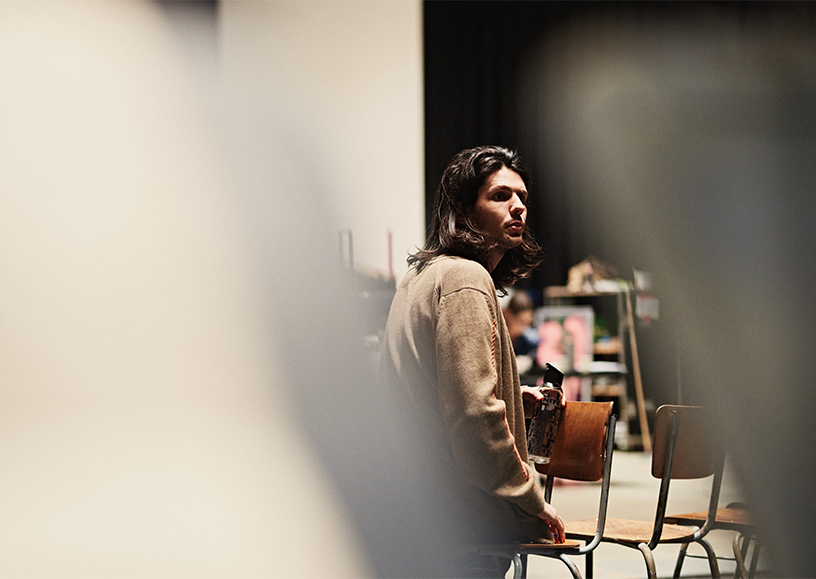
Love and revolution
An important source of inspiration, proposed by costume designer Rosa Schützendorf early on in the concept phase, was the book Liefde en revolutie (Love and Revolution, 2021) by Lotte Spreeuwenberg. In the book, Spreeuwenberg presents empathy as a driver of revolution and activism as a movement based on love. This source and the discussions about revolution as a concept — which Mart prefers to have with the entire artistic team present — led to the idea that Ändere die Welt! should be about a different kind of revolution to the one we know from the clichéd images. “It’s not my intention to make a production that criticises revolution, but we often have this idea that change will only come if we march down the streets en masse. What I hope to show is that social change doesn’t only take place on the world stage through major revolutions; contact between two people and small-scale encounters can also be very political. Change starts with a coming together, with empathy and listening to one another. The audience might be expecting a production about revolution to be rather bombastic but I thought it would be more interesting to make something on a small scale, with human interactions.”
For the set design, they played with an abstraction of the cliché image. “I found it important to have a set that didn’t evoke a particular period, where you couldn’t quite put your finger on it. I wanted to feel we were somewhere in the world, but without specifying the time or place. Vera Selhorst (the set and lighting designer, ed.) started with a visual interpretation of the barricades. To avoid ending up with a Les Misérables style decor, Vera aimed to make the image more abstract by using a single material to build the barricade, namely chairs. Chairs are household objects that you can easily drag out onto the street, but the chairs with no one sitting on them also symbolise the absence of people. As a contrast with this, we went for specificity and hyperrealism in the costumes. Rosa aimed to put the characters in clothes that would make them look like they just walked off the street onto the stage through the back door of the theatre.”
Pastiche
Ändere die Welt! is a pasticcio, a medley that is put together from scratch using existing music. There was no pre-existing story, connecting narrative, characters or dramaturgical line. “When you create a pasticcio, the danger is that it becomes an ideas-based production where everything relates to the same theme, but you can’t identify with the characters on the stage. Precisely because we were tackling such a political and topical subject, I found it incredibly important to look for the emotional and human aspects, to have recognisable, relatable characters that you can read straight away. We were able to distil various archetypes from the music, which we then translated into theatrical material.”
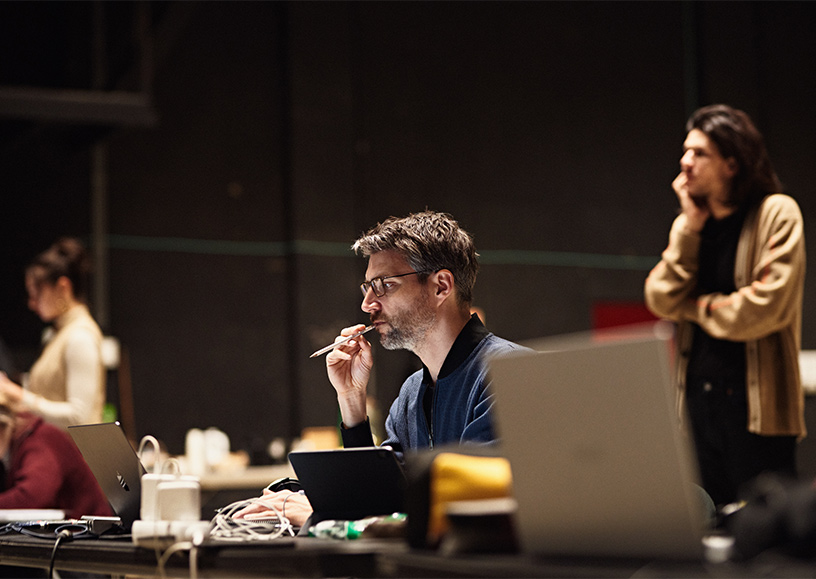
The music produced four characters. A fifth, contemporary perspective was added in the shape of Amara van der Elst, a spoken-word artist. “If you want to create a production that says something about the world today, in 2023, and you have the opportunity to put together a new collage, it doesn’t feel enough to only use voices from the nineteenth century and first half of the twentieth. I wanted the production to have multiple voices, and Amara adds a very modern touch. She is firmly rooted in the topical issues of today and her style of writing and presentation is highly musical, making it very suitable for inclusion in music theatre.”
According to Mart, that does not mean opera and spoken word are similar art forms. On the contrary, he was particularly interested in the contrast between the two. “I didn’t want to blend the art forms – I wanted them both to shine in their own right. The montage and the electronic soundscapes are used to weld them together to create a seamless whole. When you create a pasticcio, I believe it is important to embrace the fact that it is a fragmented art form. You can let that work for you rather than against you. I don’t think you should try to turn it into a single logical story from start to finish. However, it is important to get the rhythm of the evening right.” Wouter Snoei’s soundscapes differ in nature completely from the sounds of the LUDWIG ensemble, which is on stage — with Pedro Beriso as the pianist and musical leader — and therefore also has a role in the performance. Amara’s texts are also very different to the language in the lyrics sung by the classical singers. “My guiding principle is to let things work together through the contrast,” explains Mart.
Modern-day perspective
In the production, Amara adopts a perspective viewing everything as an outsider. “She is a host, or a kind of commentator or storyteller, who bridges the gap between the audience and the production’s world. She is in charge of what happens on stage. She can press ‘play’ or ‘pause’, and rewind or fast-forward events. She makes the curtain rise at the start of the performance and fall again at the end. She drives the production and calls up all the images.” Because Amara’s voice is a contemporary element in the production, it was important she was given the freedom to write her own texts. Mart and Amara were soon agreed on the content. “It was a meeting of minds in terms of our views on revolution, on change and the desire for change. And also in our rejection of a kind of blind activism that can become exclusionary or even violent. We believe much more in a form of activism that binds people and brings them together.” Mart gave Amara just one instruction. “I asked her to write down everything in the form of a question. That’s not at all common in spoken word, an art form that is often very activist and assertive. I thought it would be much more interesting to pose questions rather than make statements, as this opens things up for the audience. I also thought it would be exciting to explore how questions can be activist too. Questions are never neutral, so can questions also represent a position?”
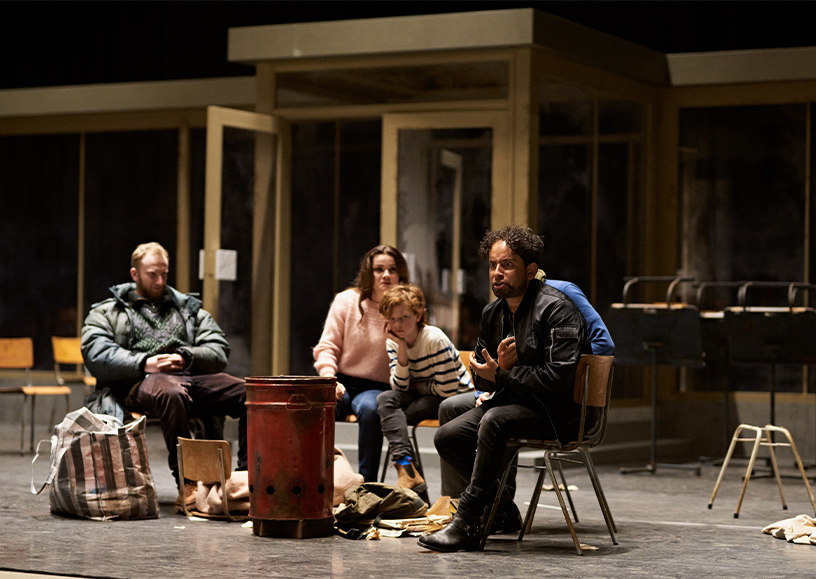
The future
While Amara gives a voice to the present day, the Child — played in turn by three child actors — symbolises the future as the sixth character on stage. “The Child is the only character in the production who neither sings nor speaks, but I see it as a leading role. When you see children, certain worldviews and images are soon evoked. We raise children with ideas about good and bad, and that requires us to talk about how we see the world. This lets the Child accentuate the contrasts between the characters, because each interaction with the Child is about how the world works or how the Child ought to see the world. The Child is a blank slate where the blanks are filled in by its environment.”
When asked how he hopes audiences will feel when they leave the theatre, Mart answers resolutely “Hopeful”. “For my generation and the generations that come after us, the idea that the world is going to the dogs can be paralysing. It’s easy to seek refuge in cynicism or passivity. But I hope this production can plant a seed of hope in the minds of audiences. I certainly don’t expect people will take to the streets in protest after seeing this performance, but I do hope they will feel change is possible, and that change is probably closer than they thought.”
Text: Jasmijn van Wijnen
Translation: Clare Wilkinson
A revolution on an intimate scale
Musical leader Pedro Beriso on creating a pasticcio
A revolution on an intimate scale
As the conductor, pianist and man responsible for the arrangements for Ändere die Welt!, Pedro Beriso faced the challenging task of selecting music for a production about revolution with just four singers and a small ensemble. Drawing on an initial idea of a production based on the music of Hanns Eisler, the German repertoire formed the baseline for an investigation into music history for music that reverberates with — or has distant echoes of — the sound of revolution.
You have to start somewhere, and in the case of Ändere die Welt! that somewhere was Hanns Eisler. “Hanns Eisler’s music is not exactly part of the canon — it isn’t well known at all. That is why I wanted to combine it with music that would ring a bell with audiences,” says Pedro. “Naturally, I then thought of Kurt Weill. His music dates from the same period, and both Weill and Eisler worked with Bertolt Brecht, who wrote the lyrics for their songs. What is more, they had the same underlying philosophy. So that became the premise: German composers who were inspired by the Russian Revolution and hoped for a similar revolution in Germany.”
That much was clear. But the investigation did not end with Eisler and Weill. Pedro delved deeper into the past in search of other historically significant social revolutions that influenced Germany and German composers. That took him to Beethoven. “Beethoven is a composer who changed the course of Western classical music, in my opinion. Beethoven was still young when the French Revolution happened — he was a child of the Revolution. The ideals of the French Revolution shaped him and other creative spirits of his generation, in particular influencing how they saw the creative process. For them, it was a question of artistry rather than the mastery of a craft. Beethoven is the prime example of that revolution in the arts, which has gone down in history as Romanticism. We chose an excerpt from Fidelio, which encompasses all the ideals of the French Revolution and the freedom of the individual, and Egmont, which is all about the idea of liberating the oppressed.”
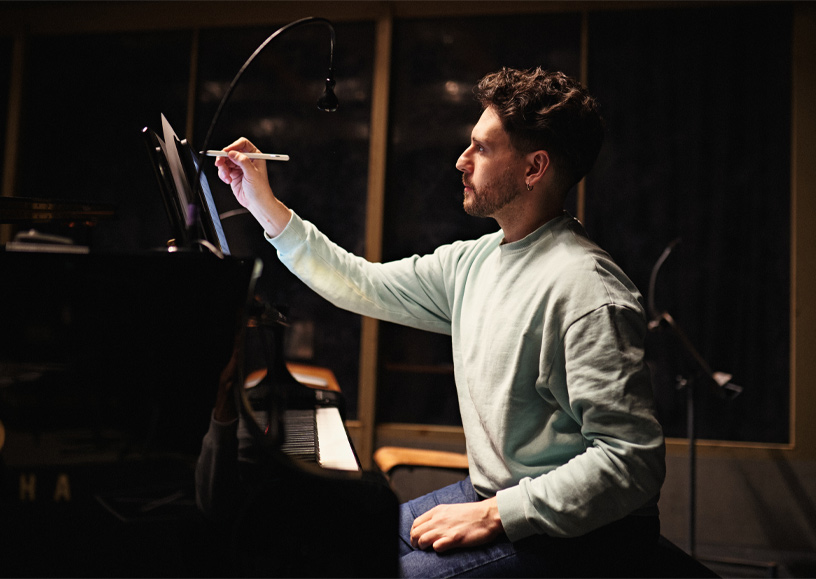
Revolution in the room
Following this historical line brings you inevitably to another key moment in the history of revolutionary music: Auber’s La muette de Portici, an opera about the uprising against Spanish rule in Naples. There is a well-known anecdote about this work: apparently, the Belgian Revolution of 1830 broke out during a performance of the opera in La Monnaie Theatre in Brussels. “Legend has it that the revolutionaries in the concert hall had agreed to rise up during the duet ‘Mieux vaut mourir’ (‘It is better to die’). We’ve included the duet in our production and rearranged it for four voices.” Of course, any revolution-themed pasticcio would have to include a nod to this story.
“Schumann and Wagner bring us to the ‘bourgeois’ revolutions of the mid-nineteenth century. Schumann made extensive use of texts by revolutionary authors such as Heinrich Heine in his music. This production includes his lied ‘Die beiden Grenadiere’. It was inspired by Napoleon’s Grande Armée, but you can also interpret it as an ironic and cynical work. Heine exaggerates the nobility of the soldiers, enabling the fanaticism of Napoleon’s supporters to be viewed from a certain critical distance.” Wagner’s link with the theme of revolution is clear. He was very politically active and even had to flee Dresden for that reason. Wagner found asylum in Switzerland, where he received assistance from Mathilde Wesendonck, a passionate admirer of his and the wife of a rich patron of the arts. Wagner composed his Wesendonck-Lieder to poems by this same Mathilde Wesendonck.
Poetry instead of propaganda
The fact that many of the songs in Ändere die Welt! are based on poems makes them more open to interpretation. While the texts do not contain explicit political statements, a certain undertone can be sensed when you know the context in which the works were created. That applies to Rachmaninoff’s music for example. “In 1917, he fled the Bolshevist regime. The nostalgia and bitterness with which he viewed his erstwhile homeland are clear in his song ‘Uzh ty, niva moya’ (‘O you, my cornfield’) to words by Tolstoy, which we have included in the production.”
“Then there is Shostakovich, who had an ambiguous role in the Russian Revolution and the Soviet Union as both victim and collaborator. The song of his we use is a protest against a certain barbaric artist. At the time it was interpreted as a criticism of the critics: Shostakovich was afraid of the censors.”
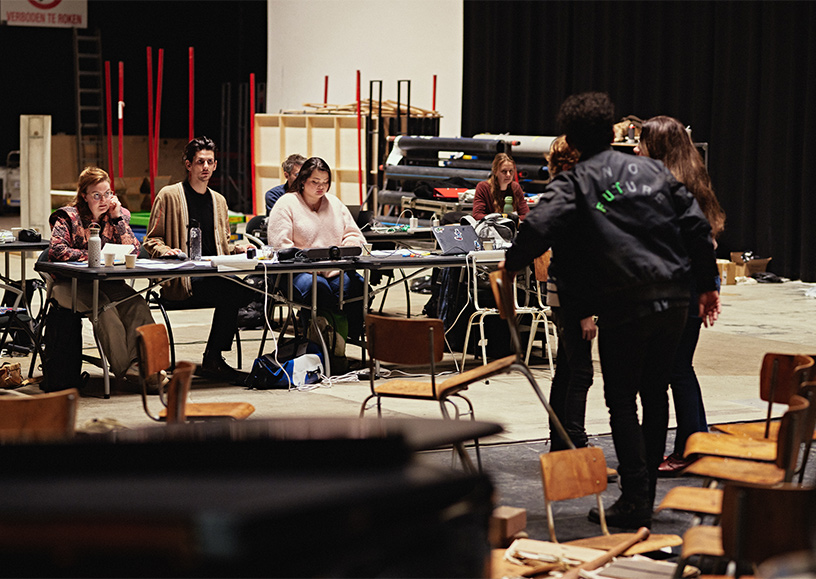
Pedro also works as a coach for Dutch National Opera Studio so he already knew most of the singers in that capacity. It meant that when selecting and allocating the songs, he could allow for the fact that he had young, talented singers at the start of their careers. “It’s not a showcase production but I did want all the singers to have an equal share of the limelight and get a chance to show off what they can do. That is why I transposed some pieces, or arranged songs for a male voice that were originally written for a woman. An example is ‘Cäsars Tod’ by Kurt Weill. In the ‘play with music’ Der Silbersee, it is treated as a proper song. The singer is asked to perform during a dinner, she picks up a harp and sings this ballad about Caesar’s death. The reference to the outside world, where the Nazis had recently seized power when this was written, is all too clear. We have four characters in the production, one of whom is ‘A Revolutionary’. It seemed more appropriate to have him sing this song.”
Pasticcio
It is not easy to put together a pasticcio. When working on a new composition you have total creative freedom but in a pasticcio you have to work with existing material. “Once I’d found the music that satisfied all my ‘musical agendas’, we then had to create a narrative arc with that material. That is the biggest challenge when compiling a pasticcio,” says Pedro. “Together with Mart, I rearranged certain songs for ensembles that were originally written for one or two people. That was partly for musical reasons — we didn’t want too many solo numbers in succession — and partly to reflect the dramatic development whereby the four adults and one child gradually come together to form a community. Wouter Snoei’s soundscapes and Amara van der Elst’s spoken word texts also helped to turn it into a cohesive whole and create a dramatic arc. They enable the music to stand out and shine in its own right.”
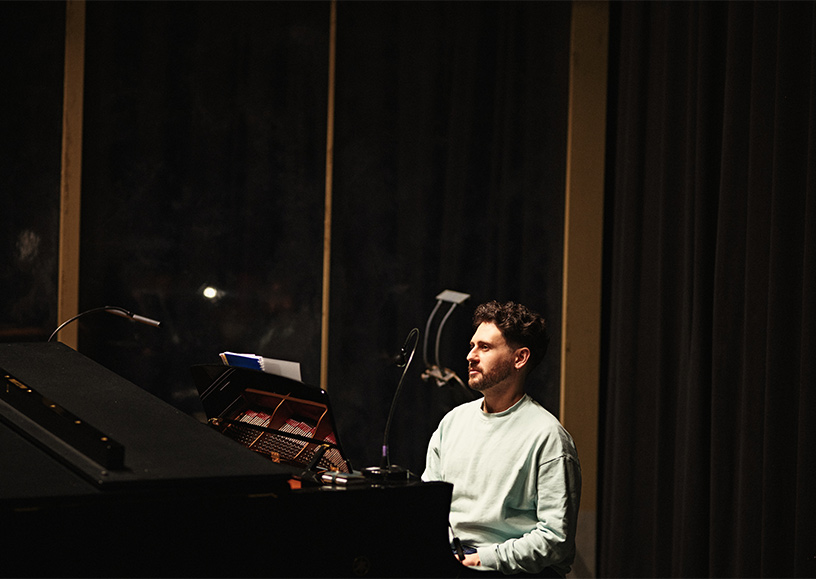
Pedro had to do a lot of arranging as the original music was from many different places and periods and composed for a wide range of singers and ensembles. “We have music that was written for symphony orchestras (the works by Beethoven and Auber), we have music written originally for piano and voice and we have the music of Weill and Eisler, which was intended for a jazz orchestra with saxophones and percussion. I wanted to bring those diverse musical worlds together by arranging them all for an ensemble consisting of a string quartet, three woodwind instruments and a piano. But I also wanted to preserve the original power of the music and treat it with respect. For that reason, I used a more symphonic approach to the orchestration of some pieces, while I used an arrangement that was closer to chamber music, or even jazzy in nature, for many other pieces. Sometimes I let the musicians perform as soloists, while at other times they are very much the accompaniment. There are also moments where you just have the piano accompanying the voice. For example, I give the piano a big role in Rachmaninoff’s music as a reference to all the amazing piano music he composed. The Hanns Eisler songs have such a marked cabaret style that I looked for something that would give the feeling of improvisation and ad-libbing, where the piano leads and at the same time can be a solo instrument.”
LUDWIG
A small group of musicians from the LUDWIG ensemble were engaged for Ändere die Welt! The musicians perform on stage, making them part of the production and the visible action. Pedro agrees that LUDWIG is the perfect partner for a production like Ändere die Welt! “They are such a young, lively and enthusiastic group of artists. Not only are they outstanding musicians, they are also performers who are open to doing more than simply playing their instruments. We knew we’d be able to count on them.” Indeed, the LUDWIG musicians do far more than merely accompany the singers in Ändere die Welt!
Pedro himself will also be on stage. He feels this adds value: “I enjoy performing. I’m used to being on the stage and get a lot of enjoyment out of it. I’ve previously conducted a Così fan tutte from the piano and those performances stand out as among my most enjoyable artistic experiences. It requires a different kind of focus from the other musicians: the movements are smaller and we have to play together much more actively, which is always the case with chamber music.” This turns Ändere die Welt! into a search for revolution on an intimate scale musically as well, with a small ensemble and set in motion by subtle movements.
Text: Jasmijn van Wijnen
Translation: Clare Wilkinson
